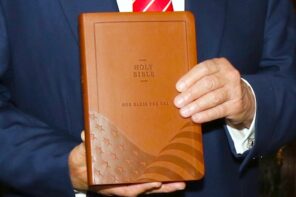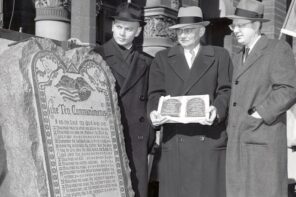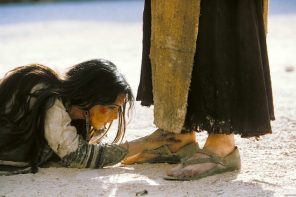In Noah Darren Aronofsky has crafted a provocative cinematic midrash weaving the stories of Genesis and stories from the book(s) of Enoch set in an antediluvian Iron Age.
Midrashic commentary traditionally fills spaces in scriptural stories, asking questions of the text, and answering those questions. Aronofsky’s choices create a new interpretation of the story of Noah—neither a good nor a bad thing in itself.
Some will care that the movie deviates from the biblical narrative. A few examples:
– Noah is not 600 and his sons are not 100. Noah is 500 when he fathers his sons (all at the same time? in the same year? Perhaps with different women) in Gen 5:32; Gen 7:6 says that Noah was 600 years old when the flood began.
– The sons of God or godlings, semi-divine God-like beings who come down from heaven to mate with human women in Gen 6:1-4 as the last straw before God floods the world do not do so in the movie. Their Enochic counterparts, the Watchers, fall from heaven to earth, become encased in soil and rock and become walking, talking piles of rock with glowing, explosive inner cores.
– The Watchers supply the bulk of the manual labor to build the ark.
– Noah’s sons are not all adult, married men when they enter the ark (Gen 7:7). The lack of wives for the boy on the cusp of manhood and the much younger boy-child are plot devices.
– When Noah gets drunk and is discovered and covered by his sons he does not curse his grandson Canaan—he doesn’t exist in the movie. (I went to see the movie in part to see how he would handle this portion because this text known as the curse of Ham, Canaan’s father, is deeply implicated in the American slave trade.)
As a biblical scholar I’m interested in the interpretive choices Aronofsky makes, particularly those which he adds to the biblical account, and the theological significance of those choices.
Not every choice has the same weight in my view; some are interesting, some are amusing and some are deadly serious. One of the most interesting innovations is the idea that Adam picked up the serpent’s shed skin in the Garden of Eden and passed it down to his children as a sign of their responsibility to care for the earth. The totemic snake skin glows with the same light as the inner core of the Watchers and a special stone called zohar, illumination.
The Zohar is the classic medieval Jewish mystical text, a source of spiritual illumination. In the movie, the stone gives off light, heat and sparks, making fire. I have to admit, I like the idea of mining for illumination—and the cautionary tale that illumination can be misused.
More imaginatively, the zohar stone also confirms a pregnancy on the ark when saliva is placed on it and fired from a projectile weapon that can only be described as a firearm. The Watchers eventually blow themselves up to allow the ark to escape from the rushing hoards.
A few more of the filmmaker’s choices:
– Bill Cosby famously asked as Noah, “God! Whose going to clean that up?” Aronofsky’s animals don’t poop on the ark because Noah and his family put them to sleep with special incense and they stay asleep the whole time. (I need some of that; I’m moving cats cross-country this summer.)
– Tubal-Cain, the first bronze and ironworker according to Gen 4:22 is Noah’s nemesis in the movie which doesn’t acknowledge that they share a father. (Compare Gen 4:12-22 and 5:28.) He becomes a stowaway on the ark and eats one of the snakes and kills one or more mammals.
– Noah doesn’t recruit wives for his younger sons because he believes they should all die on the ark and he intends to kill his grandchild if his daughter-in-law gives birth to a girl—an inversion of the Exodus genocide.
– Ham tried to kill Noah on the ark and eventually leaves the family.
– Noah tells the story of creation on the ark and the images of the cosmos come from our world, our universe, not the flat earth with arcing sun of the ancient near east.
A Nimbus of White Light
The choice that most concerns me is Aronofsky’s creation of an all white world, in the image of God.
In flashbacks to the first humans they are surrounded with a nimbus of light transparent enough to see their lily-white skins. Noah speaks of the destruction of the whole world and eventually, with great reluctance, the re-peopling of the world—which seems to be all white.
As origin stories Genesis and Enoch are not scientific texts, but they do have their own logic: earth brown humans are crafted from the brown earth humus and from them descend peoples of all nations. The ancient Israelites who crafted and preserved these stories knew people came in variety and accounted for that in their narratives. Not so Aronofsky. According to the biblical text, Noah’s descendants give rise to all peoples, theoretically divided into three major ethnic groups: Japheth gives rise to Europeans, Shem gives rise to Semites, and Ham gives rise to Africans.
The black and brown peoples who make up the majority of the world’s population and the cultures of origin from which these stories emerged simply do not exist in this telling.
Aronofsky’s Noah is another dominant culture portrayal of Afro-Asiatic folk as white folk, like the History Channel miniseries on the Bible which portrayed virtually everyone in biblical Israel, the intersection between Africa and Asia, as white. (Some even had Scottish accents. The thuggish, dreadlocked Samson was a notable, race-baiting, exception. I blogged about that series here.)
This matters because the Noah story has particular implications in the justifications of the North Atlantic slave trade. Race and racism are historically interwoven with the biblical text and its interpretation: Noah’s actions subsequent to the flood include cursing his grandson Canaan rendering him the slave of his kin, (Gen 9:27-28). The curse, articulated to his son Ham, became a major justification for the perpetual chattel slavery of Africans.
I leave it to others to judge whether the film is entertaining—it is thought provoking. The movie makes a great prompt for a discussion on biblical interpretation, and that is a good thing. I leave you the last image of Noah: passing on his blessing and the responsibility to care for the earth and all her creatures to his twin infant granddaughters. He does so with the shed skin of the serpent wound around his arm like tefilin—bands of prayer bearing the Most Holy Name of God. Interpret that!
*This essay first appeared on floodofnoah.com and is published under a Creative Commons license.




